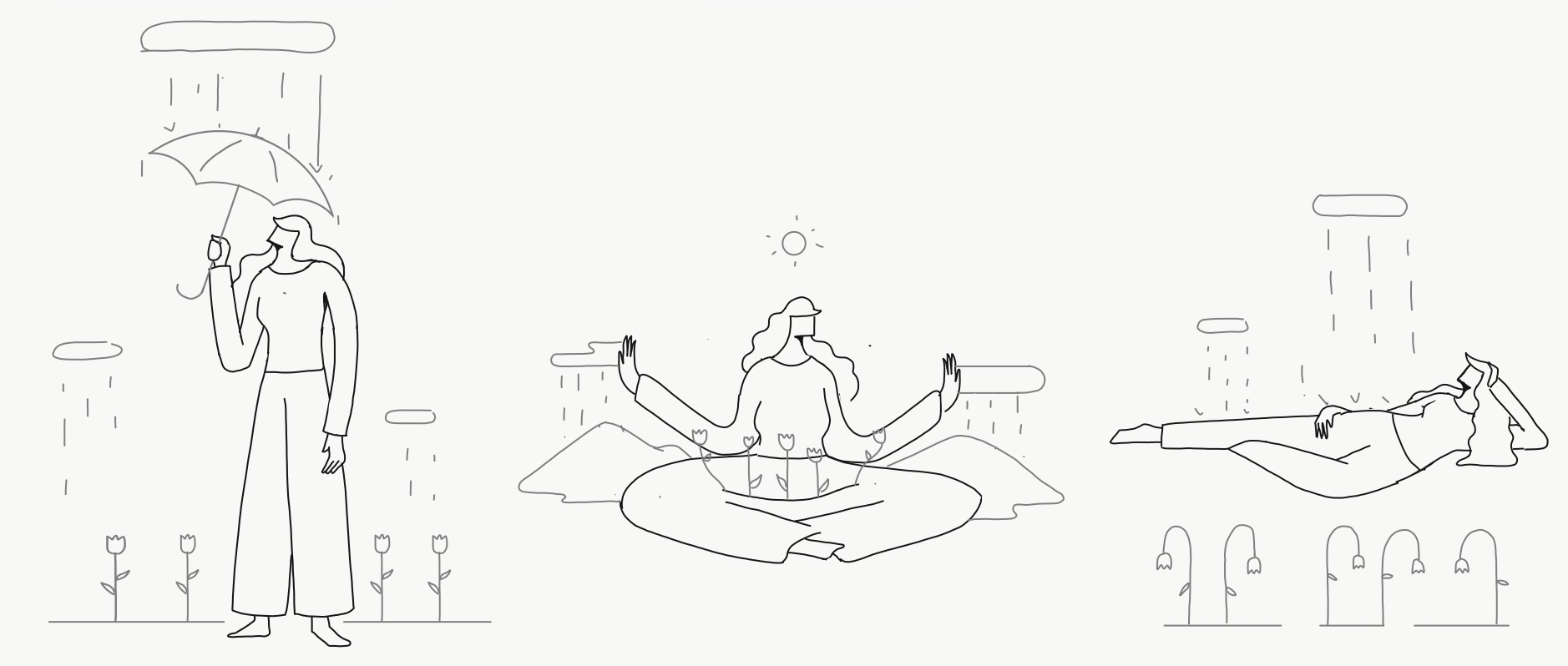Enneagram 9 in Stress: Hidden Struggles & Recovery Guide
While a Type 8 might react to pressure with a roar of frustration or a Type 3 doubles down with more work, a Nine seems to… fade. They haven’t left the room, but you can feel their emotional presence withdraw. They're still nodding and agreeable, but the spark is gone. This isn't their typical peaceful nature; it’s a quiet retreat into themselves. The enneagram 9 in stress doesn't get louder; they go silent.

The Peacekeeper's Paradox
This withdrawal is born from a difficult paradox. The very traits that make Nines so agreeable and pleasant—their adaptability, their knack for seeing all perspectives, and their deep need for peace—become their biggest hurdles when stress builds. These strengths can turn into invisible walls, trapping them in a loop of avoidance. For the Nine, dodging a conflict often stirs up more internal chaos than simply facing it.
A good way to understand this response is through the lens of over-functioning and under-functioning . While some personality types ramp up their efforts, Nines tend to under-function. Their internal system essentially goes into a low-power mode as a protective measure. This can show up in a few key ways:
• Numbing Out: • Feeling flooded by their own emotions, they mentally check out. They might turn to simple, repetitive tasks or distractions to avoid the intensity of the stress.
• Energy Depletion: • A deep, bone-weary fatigue can settle in, making even the smallest actions feel like climbing a mountain.
• Withdrawal: • They pull inward and isolate, not wanting their inner storm to disturb the calm of those around them or to feel like a burden.
• Procrastination: • Their natural indecisiveness gets worse, causing them to delay important decisions and actions in the hope that problems will magically fix themselves.
From Calm to Anxious: The Disintegration Path
This internal shutdown follows a predictable route within the Enneagram framework. When an enneagram 9 is in stress , they take on the negative characteristics of an average or unhealthy Type 6. This is known as their direction of disintegration . The easygoing, trustful Nine suddenly becomes worried, anxious, and fixated on worst-case scenarios. This shift often leads to self-sabotaging behavior as they feel more insecure and unable to find their footing.
This isn't just theory; research involving over 19,000 people confirms this dynamic, showing that Nines are among the least likely to stay productive under pressure, often becoming less active.
Understanding these stress responses is a cornerstone of using the Enneagram for personal development. These shifts are not random but are tied directly to a type's core fears and desires. If you're just starting out, learning the fundamentals is a great first step, which you can do in our guide on what the Enneagram is . Because this struggle is hidden behind a calm face, learning to see the subtle signs of overwhelm is one of the best ways to support the Nines in your life.
Reading Between The Lines: Spotting A Struggling Nine
Unlike other types who might broadcast their stress for all to see, a Nine's struggle is often written in whispers. They are masters of the phrase “I’m fine,” even when their inner world is in turmoil. This quiet suffering presents a distinct challenge: how can you spot the signs when someone is so good at becoming invisible in their distress?
When 'Yes' Really Means 'I'm Overwhelmed'
A primary indicator of an enneagram 9 in stress is a growing gap between what they say and what they do. They might agree to every plan and request, even for things they clearly have no energy for, only to "forget" or quietly back out later. This isn't a deliberate act of flakiness; it's a symptom of being completely overwhelmed.
Their deep-seated need to maintain external peace forces their own needs and feelings underground. This immense internal pressure builds until it has to escape, often leaking out as a missed appointment or an unfulfilled promise. They are trying so hard to avoid a conflict that they inadvertently create one.
This concept map shows the psychological feedback loop that drives this behavior.

As the map illustrates, their core fear of conflict and loss directly triggers withdrawal. This reaction becomes the default, overriding their fundamental desire to feel a sense of inner peace and wholeness.
To help you tell the difference between a Nine's easygoing nature and the signs of stress, it's helpful to compare their behaviors side-by-side. This table breaks down how a healthy Nine acts versus how a stressed Nine might appear.
| Behavior Area | Healthy Nine | Stressed Nine | Severity Level |
|---|---|---|---|
| Decision Making | Inclusive and deliberate, seeks consensus while being able to state own preference. | Paralyzed by choices, avoids making decisions altogether, defers to others constantly. | Moderate to High |
| Social Interaction | Genuinely present, engaged, and actively listening to others. | Withdrawn and emotionally distant, often "zoning out" during conversations. | Moderate |
| Expressing Disagreement | Can gently and diplomatically state their preferences or concerns to avoid future issues. | Resorts to stubborn silence, passive-aggressive comments, or "forgetfulness" to show dissent. | High |
| Task Management | Steady and reliable, works at a comfortable pace to get things done without rushing. | Chronic procrastination, frequently misses deadlines, feels overwhelmed by their to-do list. | High |
| Energy Levels | Calm, grounded, and stable energy. Feels reassuring to be around. | Lethargic and numb, seeks mindless distractions (e.g., scrolling, TV) to check out. | Moderate to High |
The key takeaway is the shift from active, peaceful engagement to passive, numb withdrawal . A healthy Nine is present within their peace, while a stressed Nine has retreated from it entirely.
Key Warning Signs of a Stressed Nine
Recognizing a struggling Nine means learning to translate these subtle behavioral shifts. It’s critical to differentiate between a Nine who is genuinely at peace and one who has shut down to cope with stress. Pay close attention to these telltale signs:
• Procrastination Becomes Paralysis: • What may look like simple laziness is often a state of • mental paralysis • . A stressed Nine feels so crushed by their to-do list or a big decision that they freeze, unable to take any action. The tasks ahead feel so monumental that doing nothing seems like the only manageable option.
• Withdrawal as Self-Protection: • When a normally engaged Nine pulls away, it’s not because they no longer care. It's a vital act of self-preservation. They are retreating into their inner world to conserve their dwindling energy and shield their fragile sense of peace from any more demands or disturbances.
• Passive-Aggression as a Distress Signal: • Direct confrontation can feel like an act of war to a Nine, so their pent-up anger and frustration have to find another way out. This can surface as • stubbornness, pointed silence, or "forgetting" • to do something they agreed to. Think of it as a coded message—their only way to signal dissent without risking an open conflict.
The Psychology Behind Nine Shutdown: Understanding Disintegration
When an Enneagram 9 is in stress , their reaction doesn't follow the typical fight-or-flight script. They don't gear up for a confrontation or run for the hills. Instead, they freeze, appearing to fade into the background. This isn't a passive decision; it's a deeply rooted psychological pattern known as disintegration , a predictable behavioral shift that occurs under pressure.

The Disintegration to Type Six
When stress becomes too much to handle, the normally agreeable Nine starts to take on the negative traits of an average Type Six. Their innate calm and trust evaporate, replaced by anxiety, suspicion, and a relentless parade of worst-case scenarios. This change is startling for the Nine and those who know them, as their peaceful presence gives way to a worried, hesitant state.
Imagine a circuit breaker in your home's electrical panel. When the system is overloaded with too much power, the breaker trips to prevent a fire. A Nine's shutdown works in a similar way. Their psyche "trips the breaker" to avoid a complete emotional burnout from the pressure of conflict. It’s an involuntary, self-preserving freeze designed to stop the overload.
Core Fears and Internal Pressure
This entire reaction is powered by the Nine's core fear of separation and fragmentation . To maintain harmony and avoid any conflict that might lead to being cut off from others, Nines instinctively blend with the wants and plans of those around them. While this strategy maintains external peace, it creates a serious buildup of internal pressure from their own unvoiced needs and frustrations.
This suppressed energy has to find an outlet. More recent understandings of the Enneagram show that Nines often manage this pressure by becoming less productive and retreating into comforting daydreams and mental diversions. This numbing strategy acts as a defense against the anxiety of their bottled-up stress, offering a temporary escape from reality. You can find more details on how Nines handle these overwhelming feelings in modern analyses.
This is precisely why pushing a stressed Nine to “just make a choice” or “speak up” often backfires in a big way. These demands feel like a direct assault on their inner stability, forcing them to face the very conflict their personality is built to avoid. Instead of encouraging action, it usually causes them to withdraw even further, reinforcing the belief that asserting themselves is unsafe and leads only to fragmentation.
The Productivity Paradox: Why Stressed Nines Slow Down
It’s a pattern that can be confusing for coworkers and loved ones. While many people shift into high gear under pressure, an Enneagram 9 in stress does the exact opposite: they decelerate. Just when the world demands action, they become less active and less productive, creating a cycle of guilt and misunderstanding that only deepens their stress.
This slowdown isn't a choice or a sign of laziness. It's a deep-seated, protective mechanism that kicks in automatically when a Nine feels overwhelmed.
The Hibernation Instinct
Think of a computer that detects a virus and immediately reboots into "safe mode." It restricts its functions to the bare essentials to protect its core operating system. For a Type Nine, intense stress is that virus, and their shutdown is a psychological safe mode, an unconscious effort to conserve emotional energy and avoid internal fragmentation.
This isn't just theory; it's a well-documented pattern. A major survey of over 19,000 people revealed that Nines are among the types least likely to keep their energy up when stressed. Instead, they consistently report becoming less active and productive.
To put the Type 9 response into perspective, the table below shows how different Enneagram types tend to react to pressure, highlighting the unique nature of the Nine's shutdown.
| Enneagram Type | Stress Response | Activity Level Change | Productivity Impact |
|---|---|---|---|
| Type 9 (The Peacemaker) | Withdrawal, Dissociation | Decreases Significantly | Plummets |
| Type 1 (The Reformer) | Increased Self-Criticism | Increases (Fixing Mode) | Becomes Inefficient |
| Type 3 (The Achiever) | Overworking, Frenetic Action | Increases Sharply | Initially Spikes, Then Burns Out |
| Type 6 (The Loyalist) | Anxious Scanning, Seeking Alliances | Fluctuates Wildly | Becomes Erratic |
This data shows that while other types may become inefficient or frenzied, the Nine's tendency to simply stop is a distinct and often misinterpreted reaction.
Why 'Powering Through' Backfires
Because this response is so instinctual, common advice like "just push through it" is not only unhelpful but actively harmful. Telling a stressed-out Nine to get busy is like demanding a hibernating bear run a marathon. It goes completely against their biological imperative to conserve energy and find safety.
This external pressure just adds another layer of conflict, making the Nine feel even more misunderstood and reinforcing their need to withdraw. The result isn't progress; it's paralysis. This shutdown actually serves a purpose by creating the mental and emotional space Nines need to process their feelings without completely falling apart.
This can manifest in a few key ways:
• At Work: • When facing a tight deadline, they might seem to "forget" key tasks or become unresponsive, subconsciously limiting the demands being placed on them.
• During a Crisis: • In a heated family argument, they may appear detached or suddenly focus on a mundane chore, like washing the dishes, to manage the intense emotional input.
Understanding this protective logic is the first step for Nines, their managers, and their partners. The path forward isn't to fight this rhythm but to work with it. By reducing the external pressure that triggers the shutdown, you create an environment where a Nine can naturally re-engage and become genuinely productive again.
Gentle Strategies That Actually Work For Stressed Nines
Telling a stressed-out Nine to "just do it" is like trying to douse a fire with gasoline—it only fuels their resistance. The most helpful approaches work with a Nine's nature, not against it. They honor the core need for peace while gently guiding them back to the present moment. This is about discovering momentum without force, flowing with their natural rhythm instead of fighting it.

Create Structure to Reduce Chaos
For an Enneagram Nine, external chaos feels like a personal attack on their inner harmony. Creating structure isn’t about enforcing a rigid schedule; it’s about building a calm, predictable path forward. A clear plan acts as a gentle roadmap, breaking down overwhelming tasks into smaller, less intimidating steps. This external order helps to silence the internal static that often leads to procrastination and shutdown.
• Try a Dual Planner System: • Use a digital calendar for your appointments and a physical notebook for your daily to-do list. This pairing offers both structure and a hands-on, satisfying feeling of progress.
• Celebrate the Small Wins: • The simple act of physically crossing an item off a list provides a tangible sense of accomplishment that helps push back against feelings of being stuck.
• Let Technology Do the Remembering: • Set automated reminders for follow-up emails and recurring tasks. This frees up your mental energy and prevents important things from falling through the cracks.
• Curate a Peaceful Environment: • A tidy and calming workspace reduces external distractions, making it much easier to maintain focus and a sense of quiet control.
Embrace the 'Baby Steps' Method
When a Nine feels overwhelmed, their to-do list can look like an insurmountable mountain. The ‘baby steps’ method is a powerful tool for breaking that mountain down into a series of small, manageable pebbles. The goal is to make the very next action so ridiculously small that it feels effortless, which cleverly bypasses the brain’s instinct to freeze.
For instance, instead of facing the daunting task "write the report," the first baby step could be "open a new document." The next might simply be "write a title." Each tiny success builds a bit of momentum, gently pulling you back into productive action without setting off stress alarms.
Implement Gentle Routines for Stability
Predictable routines serve as an anchor for the Nine, helping to lower decision fatigue and create a much-needed sense of safety. A simple morning routine, like reading a chapter of a book before diving into emails, can set a peaceful tone for the day and prevent the immediate rush of external demands from taking over.
An evening routine is equally important for processing the day's events and consciously disconnecting from the energy of others. This could be as simple as creating a cozy reading nook, journaling for five minutes, or listening to calm music. These practices help a Nine reconnect with their own needs and prevent unresolved tension from spilling into the next day.
These gentle, intentional strategies help Nines build resilience from a foundation of peace, not pressure. For an Enneagram 9 in stress, the path back to engagement is paved with quiet consistency, not forceful commands.
Building Long-Term Resilience: Growth Paths For Nines
For a Type Nine, finding lasting peace isn't about fighting off stress more forcefully. It’s about showing up more fully. This is the crucial shift from simply coping with an enneagram 9 in stress to intentionally building a deep-seated resilience. It means trading a fragile, passive peace for a more robust, active presence in your own life.
The Path to Integration: Embracing Type Three Energy
In the Enneagram system, every type has a built-in growth path, a direction of integration that points toward health. For Nines, that path leads directly toward the healthy, dynamic energy of a Type Three. This doesn't mean you need to become a competitive, image-focused workaholic. Far from it.
Think of it as accessing the Three’s inner toolkit: their decisiveness, self-confidence, and ability to take action. This integrated energy is the perfect remedy for the Nine's core tendency to go along to get along, often merging with others until their own needs and desires vanish. By borrowing from the Three, Nines learn to see their own voice and priorities as valuable, engaging with the world from a place of genuine self-worth.

Proactive Habits for Lasting Peace
This kind of inner strength isn't built overnight. It’s the result of small, conscious habits practiced daily. These actions help you stop stress from accumulating in the first place, allowing you to voice your needs before quiet resentment boils over. It's about maintaining a sustainable calm, not just finding a temporary escape.
Here are a few practices to begin building that inner fortitude:
• Practice ‘Healthy Selfishness’: • This isn't about being inconsiderate; it's about recognizing you have needs, too. Start small. Identify just one thing you need each day—maybe a • 15-minute • walk by yourself or time to read a chapter of a book—and follow through without feeling guilty. This simple act is like a workout for your self-prioritization muscle.
• Use Assertive 'I' Statements: • Speaking your truth doesn't have to create conflict. Using simple "I" statements allows you to express your feelings and needs clearly and gently. Saying, "I feel a bit overwhelmed and need some quiet time to recharge," is worlds more effective than just withdrawing and hoping others get the hint.
• Take Authentic Action: • Before you automatically say "yes" to another request, create a moment of pause. Ask yourself: "Does this truly line up with what • I • want or need right now?" This small step reconnects you to your own inner compass and agenda. To better understand the core motivations of your type, explore our in-depth guide on • the Peacemaker • .
Ultimately, building resilience involves your whole self. To effectively manage stress, it’s important to look at factors that affect your rest, as poor sleep can intensify feelings of anxiety and the urge to withdraw. You can learn more about this connection by reading about Sleep And Your Health . For a Type Nine, true and lasting growth begins with one simple, powerful decision: to show up for yourself first .
Supporting The Nines In Your Life: A Practical Guide
When someone we care about is struggling, our first instinct is often to jump in, ask what's wrong, and try to fix it. But for an Enneagram 9 in stress , this direct, solution-focused approach can feel like an attack, causing them to withdraw even further.
To truly help a Nine, you have to change your goal. You're not there to solve their problem for them. Instead, you're there to create an environment where they feel safe enough to reconnect with themselves and find their own way forward. Patience is your superpower , not pressure.
Creating a Safe Harbor
Think of yourself as a calm harbor during their inner storm. When a Nine goes quiet or becomes disengaged, it's a sign they are completely overloaded. Adding more demands—even well-intentioned questions like "How can I help?"—can feel like another massive wave crashing over them. The key is to reduce the external pressure.
• Offer presence, not pestering. • Simply sitting with them in silence or doing a quiet activity nearby can be incredibly powerful. Your calm presence communicates support without demanding a single thing in return.
• Lower the stakes. • If you share tasks or responsibilities, break them down into tiny, manageable steps. This makes re-engaging with the world feel far less intimidating.
• Validate their need for space. • A simple "I can see you’re having a tough day. Take all the time you need" can be a profound gift. It gives them permission to feel what they're feeling without the added burden of guilt.
Communication That Connects, Not Pushes
When it is time to talk, choose your words with care. The goal is to gently invite them out of their retreat, not pull them out. Use soft, open-ended questions that don't have a right or wrong answer. For example, instead of asking, "Why are you so quiet?" try, "I’m wondering what’s on your mind?"
This patient approach builds the deep trust required for any healthy dynamic. Strengthening these bonds is a journey, and you can explore more strategies in our guide on Enneagram relationships . To empower a Nine to build their own resilience, you can also gently suggest resources that help them get to know themselves better. When they are ready, a guide to help them find your true self can be a wonderful next step.
Understanding these nuances can make all the difference. Discover your own Enneagram type and gain deeper insights into your relationships with our free, scientifically validated assessment. At Enneagram Universe , we provide the tools to foster better communication and authentic connections. Take the first step toward greater self-awareness and stronger relationships today.